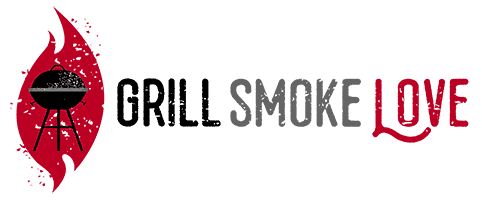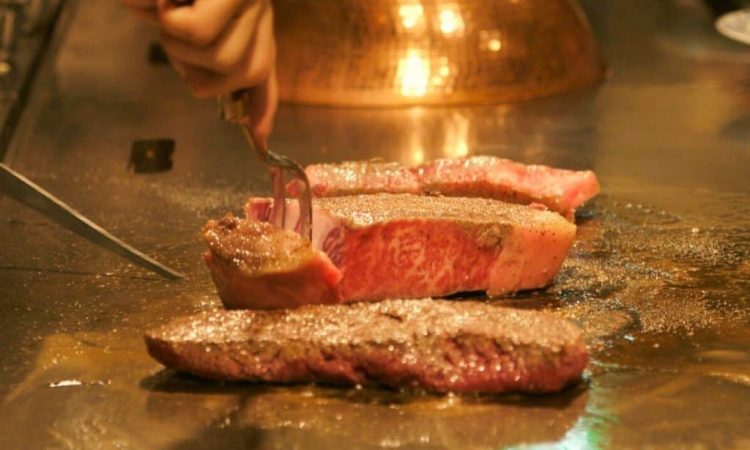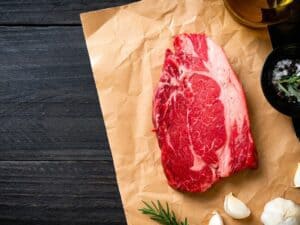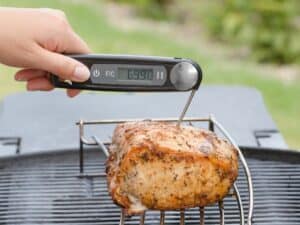In the world of premium steaks, there’s no substitute for the best. Commanding hundreds of dollars per steak, Kobe beef is perhaps one of the world’s most exclusive brand names.
Chances are you’ve seen it on restaurant menus and even at the butcher counter, but are you getting the real deal?
There’s a lot of confusion, and sometimes the terms are used in misleading ways. Kobe is just one premium brand from Japan.
Let’s clear the air, define these terms, and look at the best ways to prepare this exquisite meat.
Continue reading to find out what precisely are Wagyu and Kobe beef. I’ll also explain how can you get the real thing in the US and how to cook it at home.
What is Wagyu Beef?
Beef is a serious business in Japan, where consumers know the bloodlines and exact breeds of cattle that produce their meat.
The term Wagyu (pronounced WAH-gyoo) simply means “Japanese cow,” and it includes four specific cattle breeds and many bloodlines. Japanese beef is also often categorized based on what region of the country it comes from.
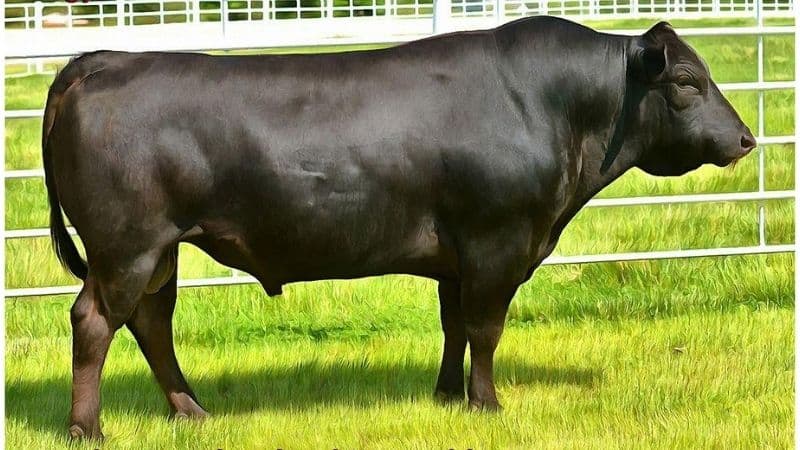
The 4 primary breeds of cattle in Japan considered Wagyu are:
- Japanese Black (Kuroge Washu): Developed in south-western Japan and accounting for over 80% of the cattle national beef herd.
- Japanese Brown (Kassyoku Washu): Slightly larger than Japanese Black and developed in the southern part of the country. About 5% of the national beef herd belongs to this breed.
- Japanese Shorthorn (Nihon Tankakushu): This small breed was developed in the northern part of Honshu island and constitutes about 1% of Japanese cattle in Japan.
- Japanese Polled (Mukaku Washu): A small and critically-endangered breed.
The only one of these Wagyu breeds to get the highest ratings and make the cut for the luxury beef brands is the Black, or Kuroge Washu.
Cattle are further divided into bloodlines to trace lineage. The Tajima bloodline is the most important. This genetic group comes from the Japanese Black cattle, and it’s the basis of two of the three prominent luxury beef brands. Each bloodline developed due to geographic isolation within the country.
During the Meiji era in Japan, work was begun on making the Wagyu a high-quality beef product, so they started breeding programs to add other desirable characteristics like heft. Even though Wagyu has been crossbred with some European cattle varieties over the years, it retains its characteristics as the most premium beef you can buy in the world.
Why is Wagyu Special?
The Asian cattle that started the trend were bred for unique hard working conditions. They were originally draft animals that were selected for their physical endurance. The result was that over the centuries, they developed a unique ability to store energy.
Wagyu store much of their energy in intramuscular fat cells, which chefs know as marbling.
Wagyu meat is more finely marbled than any other breed of cow or any other animal in the world. That level of marbling changes the texture of the meat to make it silky soft. Another breed well known for its marbling is the Angus cattle.
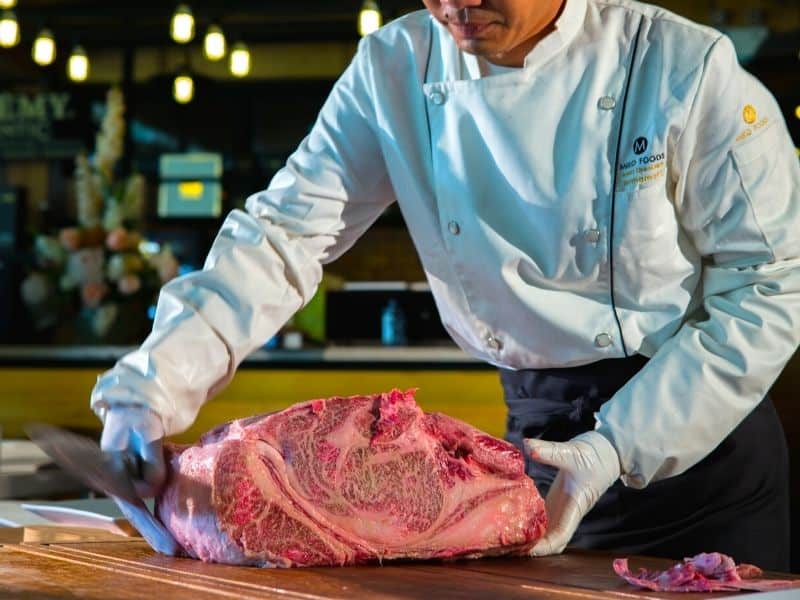
Many describe it as an unrivaled eating experience. The qualities of the fat marbling in the meat mean it melts at lower temperatures, and the meat has a lot of umami. Umami is the Japanese word used by chefs to describe the flavor of subtle sweetness and savoriness, and it’s an integral part of what makes the meat so delicious.
Wagyu is also better for you for a variety of reasons. It has a higher ratio of mono-unsaturated to saturated fats than any other type of beef, with a high concentration of healthy omega-3 and omega-6 fatty acids. Even the saturated fats present in Wagyu have been found to have a minimal impact on raising cholesterol levels.
There is more than genetics at play in making a quality Wagyu steak. The cattle’s diet and exercise are carefully controlled, and everything that can be done to contribute to quality marbling is done.
Wagyu begin a special feeding program when they’re around ten months old. Ranchers know precisely the right combination of grain, grass, and free-range roaming to allow their cows. Raising Wagyu is a folk art in Japan, and some ranchers only care for two animals at a time.
Wagyu Rating Systems
In the late 1800s, Japan began to see its exquisite beef’s commercial value, and they began to establish highly regulated breeding programs.
The Japanese use a structured system for categorizing how well beef is marbled since it is so essential to what makes Wagyu special. Known as the BMS, or beef marbling standard, the scale goes from 0 to 12.
Most premium beef sold and eaten in Japan falls somewhere between 4 and 7 on the scale. Meats higher than 9 are considered too fatty for someone to eat an entire steak; they are more of a work of art than dinner.
USDA Prime, which is the best designation for American beef, is about a 4 or 5 on the Japanese scale. The Angus beef sold and consumed commonly in the US falls somewhere around a 2.
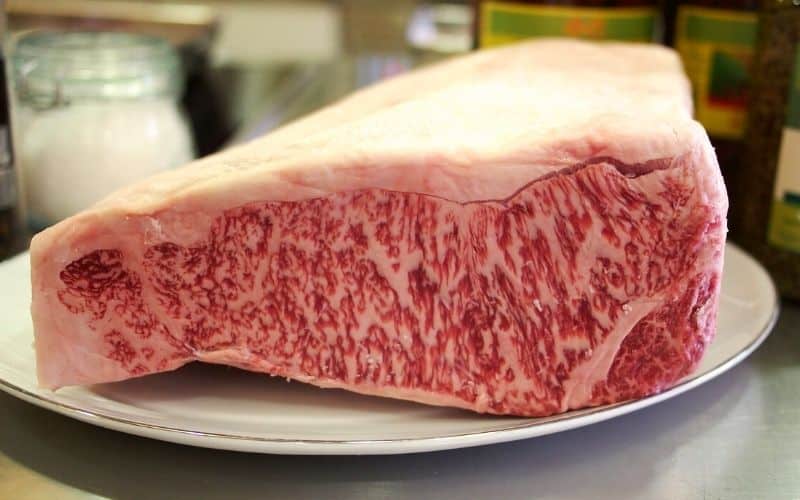
The Japanese also use another system for measuring the quality of their beef. It’s a two-digit code, based on a yield rating and a rating of the quality of the flesh.
The highest rating in the system is A5 Wagyu. To achieve this rating, the meat must have been raised in Japan and have a BMS of somewhere between 8 and 12. The more common A4 Wagyu would have a BMS between 5 and 7.
What is Kobe Beef? What Makes It So Famous?
Brand names can be useful for differentiating beef with different qualities and origins, and Kobe is no different.
While Wagyu refers to any Japanese beef, Kobe is a particular brand of Wagyu–Kobe beef that only comes from the Hyogo prefecture.
To be labeled as Kobe beef, the meat must pass several inspections. It must score a six or higher on the Japanese marbling scale, the carcass must meet specific weight requirements, pass a defect inspection, and have a yield of grade A or B.
Also, the cow must have been a Japanese Black (Kuroge Washu) born and raised in Hyogo prefecture, as must its ancestors. It must be 100% from the Tajima bloodline.
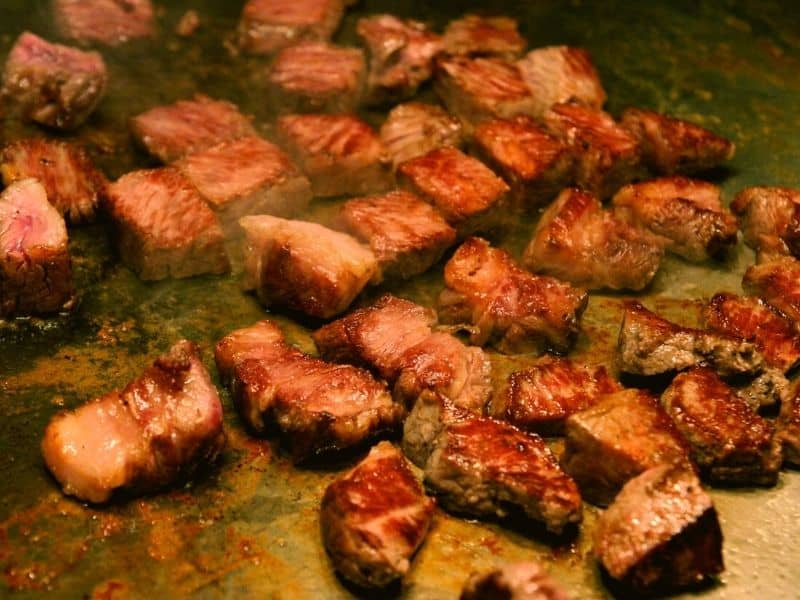
According to Bon Appetit, the Hyogo government keeps the 12 best bulls in a special facility, and all cows are inseminated from these top 12 males. The strict control of the genetics involved in producing Kobe beef keeps it exclusive to the region and ensures that it remains pure.
Where Can You Eat It?
Even with these strict controls, only about half of the total beef produced in the prefecture makes the final cut as Kobe. In total, only about 3,000 to 4,000 head of cattle get the brand label.
It’s so scarce that the brand licenses individual restaurants, and is rarely sold at retail.
You can see the list of restaurants online, and there are nine in the US, and only one of those is on the east coast!
There are two other major luxury brands of beef in Japan, including Matsusaka and Omi. But Kobe has become the best-known luxury beef brand in and outside of the country. It is synonymous with the best of the best, both in terms of overall quality and taste. As a result, the name is often used by marketers to imply greatness.
Wagyu and Kobe in America
In the US, skillful marketing and misleading labeling have led to a lot of confusion over what makes beef Wagyu or Kobe and how it’s different from anything else at the butcher’s counter.
In the 1970s, Japan began exporting Wagyu cattle to the US to re-import the meat. But by the 1990s, the Japanese government banned the export of their prized cattle.
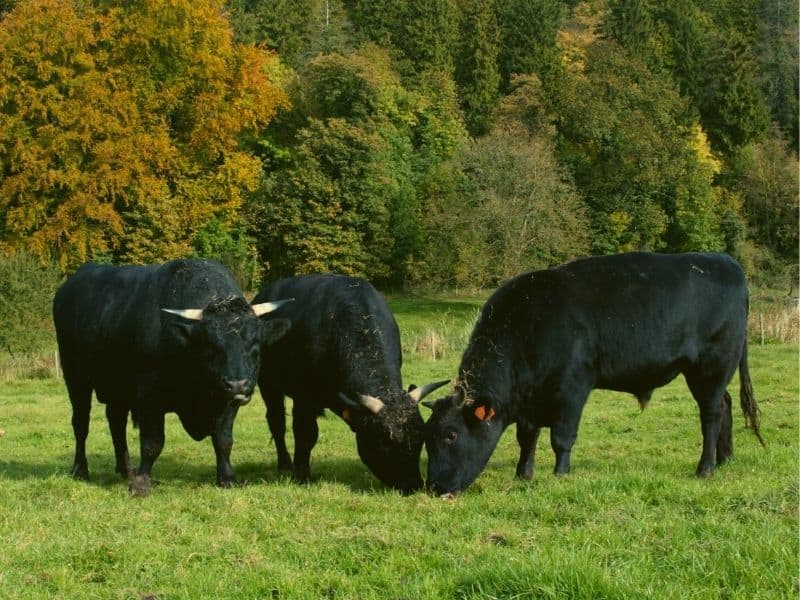
Over those twenty-or-so years, American farms were able to create herds that are still producing today. Most of the product was exported back to Japan until 2003 when many countries banned the importation of US-grown beef.
Many of these cattle have been crossbred with American bloodlines. They are often branded as Wangus, which is Wagyu crossbred with Angus. Most of what you will find for sale at restaurants and supermarkets is Percentage Wagyu or a domestic breed with a minimal amount of Wagyu ancestry.
The American Wagyu Association defines the genetics and labeling of Wagyu in the US as follows:
- Full-blood Wagyu comes from animals who had full-blood parents.
- Purebred Wagyu requires the parents to have had 15/16 or more Wagyu blood.
- Percentage Wagyu and recorded Wagyu groups have fewer Wagyu traits.
Breeders and farmers pay careful attention to all of this since Wagyu is an exceptional product worth preserving.
The American Wagyu Association maintains a list of Wagyu breeders in the US. According to their website, there are about 26,000 Wagyu cattle in the US or about 0.029% of the total US cattle population.
“Kobe Beef” is a common marketing buzzword in the US. But it’s essential to understand that very little beef is imported to the US from Japan.
Authentic Kobe beef must be grown in Japan, so the chances that you are actually getting Kobe is slim. More likely, what is being sold is “American Kobe” or “Wagyu.” And chances are, these are just Angus with a small percentage of Wagyu blood. Furthermore, since Wagyu is never ground, any Wagyu burger or ground product is definitely not the real deal.
Are Kobe and Wagyu Beef Worth the Price?
So the meat is hard to find and expensive. Is it any better than the regular Angus you can find anywhere?
The chances that a consumer would be able to notice the difference side-by-side is debatable. In the end, it’s clever marketing used to command higher prices for a somewhat similar product. It’s rare to find purebred or full-blood Wagyu in the US at all, and when you do, it’s expensive. The easiest way to ensure that you’re getting what you want is to get your meat directly from the farm.
When looking at a restaurant or the meat counter, you’ll want to look for A5 or A4 Wagyu, or Wagyu listed as “from Japan”. You’ll often see a specific prefecture listed as well.
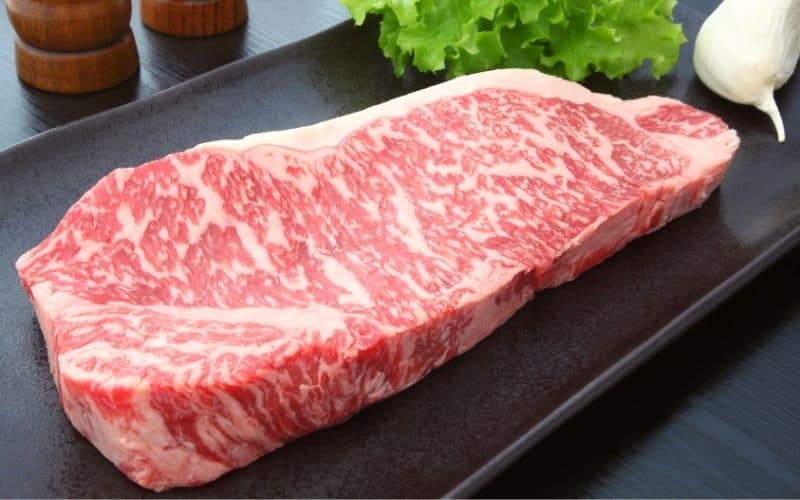
Wagyu can only be exported from Japan boneless, so the real stuff is usually sold as strip, filet, or ribeye. The average prices start at $20 per ounce, but restaurant prices will be higher.
Another good tip for restaurants: if you’re in doubt, ask the waiter. It’s hard to get real Wagyu, so if the waiter doesn’t know exactly where the beef comes from, chances are it’s not real.
How to Cook Wagyu at Home
If you are going to try your hand at cooking the best steak in the world, you’ll want to find the authentic stuff.
Look for beef labeled “full-blood” or “purebred” Wagyu. “F1 Cross” 50% Wagyu is another option.
Beyond these labels, anything else found in the US is likely just Wangus. You can find a list of Wagyu breeders and farms in the US on the American Wagyu Association website.
Since Wagyu is so much richer than American Angus beef, it is typically cut and prepared differently. Wagyu is all about savoring every bite, and they are traditionally prepared as an experience, not as a meal. You don’t devour a substantial thick-cut steak; you enjoy thin-cut small portions.
Imported Wagyu will be cut differently than American cuts. Ribeyes and striploin will be only 3/4-inch thick, while tenderloin will target eight ounces. It’s also important to realize that ground beef is never made from Wagyu meat. In Japan, small bite-sized cuts are sold as “Kiri-otishi” and are labeled based on what part of the animal it comes from.
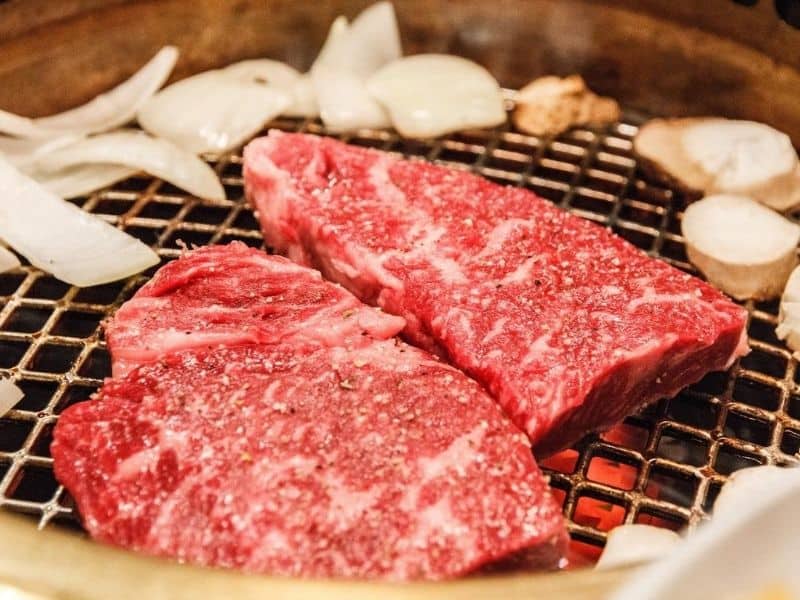
Typical Japanese preparation for Wagyu is also different. Tough cuts like top or bottom round that would usually be braised, slow-cooked, or smoked in the US, are usually cut paper-thin and cooked in broth. Steaks are seared quickly on a teppanyaki grill or in a pan, warming the meat just enough to melt the interior fat marbling.
You can also cut the meat into small cubes and put them on skewers to be cooked on a yakitori grill or cook thin slices on a Korean style grill pan.
Even if you don’t adopt the traditional cooking methods, it’s worth your time to think about how you’re going to prepare the meat. It’s no small feat to get your hands on A5 Wagyu, so it should be a treat.
When cooking Wagyu, you can’t go wrong with these tips:
- Before cooking, bring the meat to room temperature.
- Use light seasoning and a quick sear on the grill or pan.
- Be careful not to overcook the meat, and then let it rest for twice as long as you cooked it.
- Any sauce that you use should be simple and light.
Remember, the meat itself is richer than anything you cook regularly. Traditional accompaniments include sea salt, soy sauce, wasabi, miso paste, or fried garlic chips.
And there you have it, everything you need to know about Wagyu and Kobe beef!
If you find a piece of Japanese A5 Wagyu, make sure to savor every bite and enjoy it for what it is – one of the best cuts of meat money can buy.
Enjoy!
-Joonas
